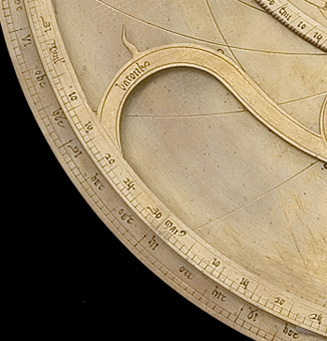| Date | ca. 1350 |
| Place | Oxford |
| Material | Brass |
| Inventory no. | 47901 |
| Acquisition | Lent by Oriel College, Oxford, in 1924 |
A number of features make this astrolabe unusual. It consists of a single, thin plate. One side is engraved with the typical stereographic projection of the celestial sphere; the back bears a quadrant. It was uncommon for European astrolabists to make an instrument with only a single plate. In this case, the plate is engraved for 51°, intended as the latitude of Oxford. Since there are neither limb nor womb, the Y-shaped rete is rivetted to the plate.
Another unusual feature of this astrolabe is the calendar found on the outer band of the rete, the Tropic of Capricorn. Most astrolabes have the calendar on the back of the instrument, where there is also a scale of the signs of the zodiac. Since the entire back of this instrument is engraved with a quadrant, the maker had to relocate the calendar. His ingenious solution was to place it on the rete, where there is already a zodiac. The pragmatic and utilitarian design of this instrument suggests that it was intended to be used; certainly, the quadrant on the back provides a larger scale and thus greater precision than usual.
This astrolabe belongs to Oriel College and may have come to the college from one of its early fellows. At least one 14th-century Oxford astronomer bequeathed astrolabes in this way: in his will, Simon Bredon provided his college (Merton) with a large astrolabe. He was one of the group of mathematicians known as the 'Merton School', and the Oriel instrument similarly emerges from this 14th-century scientific and mathematical renaissance in Oxford. Both astrolabes have all the appearance of having been designed, possibly even made, by scholars for their own use.
View all
images for this astrolabe
View
detailed provenance for this astrolabe
Back
The back contains 3 scales of the following types: Degree; Quadrant arc; Unequal hours. More informationRete, Rivet
The rete contains 17 stars. The zodiac on the rete is labelled: Aries , Tau , Gei , Can , Leo , Vir , Libra , SScor9 , SSag9 , Cap' , Aquar9 , Pisc'.The rete contains 2 scales of the following types: Calendar; Ecliptic.
The rete is attached using a rivet. More information
Rules & Alidades
| Type | Details |
|---|---|
| Pointer | Single-ended. The pointer has broken off and is now
lost. From the fragment still attached, it is clear that
this was a pointer. |


